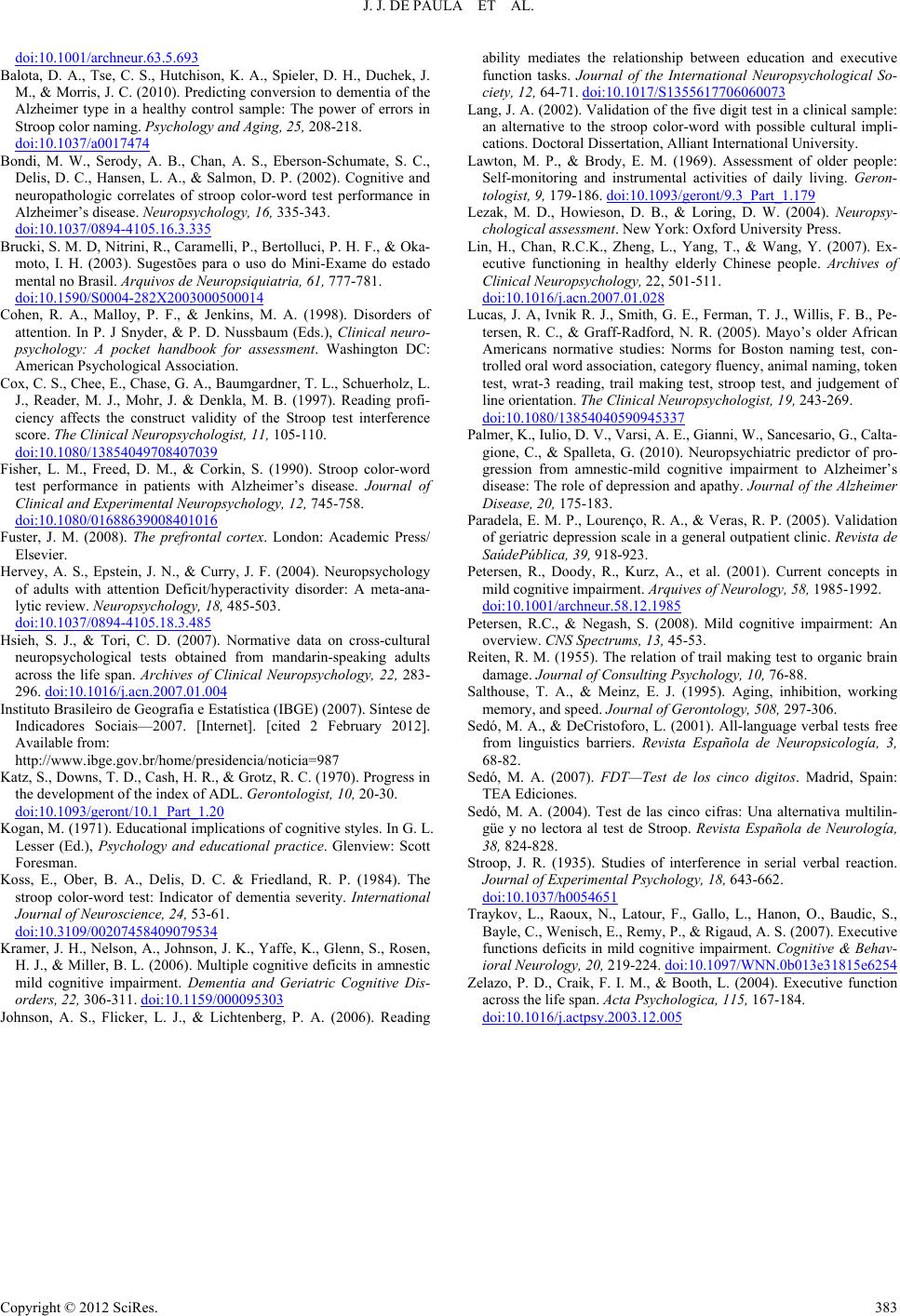
J. J. DE PAULA ET AL.
doi:10.1001/archneur.63.5.693
Balota, D. A., Tse, C. S., Hutchison, K. A., Spieler, D. H., Duchek, J.
M., & Morris, J. C. (2010). Predicting conversion to dementia of the
Alzheimer type in a healthy control sample: The power of errors in
Stroop color naming. Psychology and Aging, 25, 208-218.
doi:10.1037/a0017474
Bondi, M. W., Serody, A. B., Chan, A. S., Eberson-Schumate, S. C.,
Delis, D. C., Hansen, L. A., & Salmon, D. P. (2002). Cognitive and
neuropathologic correlates of stroop color-word test performance in
Alzheimer’s disease. Neuropsychology, 16, 335-343.
doi:10.1037/0894-4105.16.3.335
Brucki, S. M. D, Nitrini, R., Caramelli, P., Bertolluci, P. H. F., & Oka-
moto, I. H. (2003). Sugestões para o uso do Mini-Exame do estado
mental no Brasil. Arquivos de Neuropsiquiatria, 61, 777-781.
doi:10.1590/S0004-282X2003000500014
Cohen, R. A., Malloy, P. F., & Jenkins, M. A. (1998). Disorders of
attention. In P. J Snyder, & P. D. Nussbaum (Eds.), Clinical neuro-
psychology: A pocket handbook for assessment. Washington DC:
American Psychological Association.
Cox, C. S., Chee, E., Chase, G. A., Baumgardner, T. L., Schuerholz, L.
J., Reader, M. J., Mohr, J. & Denkla, M. B. (1997). Reading profi-
ciency affects the construct validity of the Stroop test interference
score. The Clinical Ne u ro p s yc h o logist, 11, 105-110.
doi:10.1080/13854049708407039
Fisher, L. M., Freed, D. M., & Corkin, S. (1990). Stroop color-word
test performance in patients with Alzheimer’s disease. Journal of
Clinical and Experimental N europ sychology, 12, 745-758.
doi:10.1080/01688639008401016
Fuster, J. M. (2008). The prefrontal cortex. London: Academic Press/
Elsevier.
Hervey, A. S., Epstein, J. N., & Curry, J. F. (2004). Neuropsychology
of adults with attention Deficit/hyperactivity disorder: A meta-ana-
lytic review. Neuropsychology, 18, 485-503.
doi:10.1037/0894-4105.18.3.485
Hsieh, S. J., & Tori, C. D. (2007). Normative data on cross-cultural
neuropsychological tests obtained from mandarin-speaking adults
across the life span. Archives of Clinical Neuropsychology, 22, 283-
296. doi:10.1016/j.acn.2007.01.004
Instituto Brasileiro de Geografia e Estatística (IBGE) (2007). Síntese de
Indicadores Sociais—2007. [Internet]. [cited 2 February 2012].
Available from:
http://www.ibge.gov.br/home/presidencia/noticia=987
Katz, S., Downs, T. D., Cash, H. R., & Grotz, R. C. (1970). Progress in
the development of the index of ADL. Gerontologist, 10, 20-30.
doi:10.1093/geront/10.1_Part_1.20
Kogan, M. (1971). Educational implications of cognitive styles. In G. L.
Lesser (Ed.), Psychology and educational practice. Glenview: Scott
Foresman.
Koss, E., Ober, B. A., Delis, D. C. & Friedland, R. P. (1984). The
stroop color-word test: Indicator of dementia severity. International
Journal of Neuroscience, 24, 53-61.
doi:10.3109/00207458409079534
Kramer, J. H., Nelson, A., Johnson, J. K., Yaffe, K., Glenn, S., Rosen,
H. J., & Miller, B. L. (2006). Multiple cognitive deficits in amnestic
mild cognitive impairment. Dementia and Geriatric Cognitive Dis-
orders, 22, 306-311. doi:10.1159/000095303
Johnson, A. S., Flicker, L. J., & Lichtenberg, P. A. (2006). Reading
ability mediates the relationship between education and executive
function tasks. Journal of the International Neuropsychological So-
ciety, 12, 64-71. doi:10.1017/S1355617706060073
Lang, J. A. (2002). Validation of the five digit test in a clinical sample:
an alternative to the stroop color-word with possible cultural impli-
cations. Doctoral Dissertation, Alliant International University.
Lawton, M. P., & Brody, E. M. (1969). Assessment of older people:
Self-monitoring and instrumental activities of daily living. Geron-
tologist, 9, 179-186. doi:10.1093/geront/9.3_Part_1.179
Lezak, M. D., Howieson, D. B., & Loring, D. W. (2004). Neuropsy-
chological assessment. New York: Oxford University Press.
Lin, H., Chan, R.C.K., Zheng, L., Yang, T., & Wang, Y. (2007). Ex-
ecutive functioning in healthy elderly Chinese people. Archives of
Clinical Neuropsychology, 22, 501-511.
doi:10.1016/j.acn.2007.01.028
Lucas, J. A, Ivnik R. J., Smith, G. E., Ferman, T. J., Willis, F. B., Pe-
tersen, R. C., & Graff-Radford, N. R. (2005). Mayo’s older African
Americans normative studies: Norms for Boston naming test, con-
trolled oral word association, category fluency, animal naming, token
test, wrat-3 reading, trail making test, stroop test, and judgement of
line orientation. The Clinical Neuropsychologist, 19, 243-269.
doi:10.1080/13854040590945337
Palmer, K., Iulio, D. V., Varsi, A. E., Gianni, W., Sancesario, G., Calta-
gione, C., & Spalleta, G. (2010). Neuropsychiatric predictor of pro-
gression from amnestic-mild cognitive impairment to Alzheimer’s
disease: The role of depression and apathy. Journal of the Alzheimer
Disease, 20, 175-183.
Paradela, E. M. P., Lourenço, R. A., & Veras, R. P. (2005). Validation
of geriatric depression scale in a general outpatient clinic. Revista de
SaúdePública, 39, 918-923.
Petersen, R., Doody, R., Kurz, A., et al. (2001). Current concepts in
mild cognitive impairment. Arquives of Neurology, 58, 1985-1992.
doi:10.1001/archneur.58.12.1985
Petersen, R.C., & Negash, S. (2008). Mild cognitive impairment: An
overview. CNS Spectrums, 13, 45-53.
Reiten, R. M. (1955). The relation of trail making test to organic brain
damage. Jo urna l of Con sul ting Psychology, 10, 76-88.
Salthouse, T. A., & Meinz, E. J. (1995). Aging, inhibition, working
memory, and speed. Journal of Gerontology, 508, 297-306.
Sedó, M. A., & DeCristoforo, L. (2001). All-language verbal tests free
from linguistics barriers. Revista Española de Neuropsicología, 3,
68-82.
Sedó, M. A. (2007). FDT—Test de los cinco digitos. Madrid, Spain:
TEA Ediciones.
Sedó, M. A. (2004). Test de las cinco cifras: Una alternativa multilin-
güe y no lectora al test de Stroop. Revista Española de Neurología,
38, 824-828.
Stroop, J. R. (1935). Studies of interference in serial verbal reaction.
Journal of Experimental Ps ych olog y, 18, 643-662.
doi:10.1037/h0054651
Traykov, L., Raoux, N., Latour, F., Gallo, L., Hanon, O., Baudic, S.,
Bayle, C., Wenisch, E., Remy, P., & Rigaud, A. S. (2007). Executive
functions deficits in mild cognitive impairment. Cognitive & Behav-
ioral Neurology, 20, 219-224. doi:10.1097/WNN.0b013e31815e6254
Zelazo, P. D., Craik, F. I. M., & Booth, L. (2004). Executive function
across the life span. Acta Psychologica, 115, 167-184.
doi:10.1016/j.actpsy.2003.12.005
Copyright © 2012 SciRes. 383